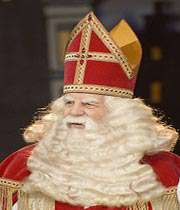Legendary gift-bringing figures in Christmas
A number of figures of both Christian and mythical origin have been associated with Christmas and the seasonal giving of gifts.
Among these are Father Christmas, also known as Santa Claus, Père Noël, and the Weihnachtsmann; Saint Nicholas or Sinterklaas; the Christkind; Kris Kringle; Joulupukki; Babbo Natale; Saint Basil; and Father Frost.
The most famous and pervasive of these figures in modern celebration worldwide is Santa Claus, a mythical gift bringer, dressed in red, whose origins have diverse sources. The name Santa Claus can be traced back to the Dutch Sinterklaas, which means simply Saint Nicholas. Nicholas was Bishop of Myra, in modern day Turkey, during the 4th century. Among other saintly attributes, he was noted for the care of Children, generosity, and the giving of gifts. His feast on the 6th of December came to be celebrated in many countries with the giving of gifts. Saint Nicholas traditionally appeared in bishop's attire, accompanied by helpers, inquiring about the behaviour of children during the past year before deciding whether they deserved a gift or not. By the 13th century, Saint Nicholas was well known in the Netherlands, and the practice of gift-giving in his name spread to other parts of central and southern Europe. At the Reformation in 16th–17th century Europe, many Protestants changed the gift bringer to the Christ Child or Christkindl, corrupted in English to Kris Kringle, and the date of giving gifts changed from December the 6th to Christmas Eve.
The modern popular image of Santa Claus, however, was created in the United States, and in particular in New York. The transformation was accomplished with the aid of notable contributors including Washington Irving and the German-American cartoonist Thomas Nast (1840–1902). Following the American Revolutionary War, some of the inhabitants of New York City sought out symbols of the city's non-English past. New York had originally been established as the Dutch colonial town of New Amsterdam and the Dutch Sinterklaas tradition was reinvented as Saint Nicholas. In 1809, the New-York Historical Society convened and retroactively named Sancte Claus the patron saint of Nieuw Amsterdam, the Dutch name for New York City. At his first American appearance in 1810, Santa Claus was drawn in bishops' robes. However as new artists took over, Santa Claus developed more secular attire. Nast drew a new image of "Santa Claus" annually, beginning in 1863. By the 1880s, Nast's Santa had evolved into the robed, fur clad, form we now recognize, perhaps based on the English figure of Father Christmas. The image was standardized by advertisers in the 1920s.
Santa Claus is famous around the world for giving gifts to good childrenFather Christmas, a jolly, well nourished, bearded man who typified the spirit of good cheer at Christmas, predates the Santa Claus character. He is first recorded in early 17th century England, but was associated with holiday merrymaking and drunkenness rather than the bringing of gifts. In Victorian Britain, his image was remade to match that of Santa. The French Père Noël evolved along similar lines, eventually adopting the Santa image. In Italy, Babbo Natale acts as Santa Claus, while La Befana is the bringer of gifts and arrives on the eve of the Epiphany. It is said that La Befana set out to bring the baby Jesus gifts, but got lost along the way. Now, she brings gifts to all children. In some cultures Santa Claus is accompanied by Knecht Ruprecht, or Black Peter. In other versions, elves make the toys. His wife is referred to as Mrs. Claus.

There has been some opposition to the narrative of the American evolution of Saint Nicholas into the modern Santa. It has been claimed that the Saint Nicholas Society was not founded until 1835, almost half a century after the end of the American War of Independence. Moreover, a study of the "children's books, periodicals and journals" of New Amsterdam by Charles Jones revealed no references to Saint Nicholas or Sinterklaas. However, not all scholars agree with Jones's findings, which he reiterated in a booklength study in 1978; Howard G. Hageman, of New Brunswick Theological Seminary, maintains that the tradition of celebrating Sinterklaas in New York was alive and well from the early settlement of the Hudson Valley on.
Current tradition in several Latin American countries (such as Venezuela and Colombia) holds that while Santa makes the toys, he then gives them to the Baby Jesus, who is the one who actually delivers them to the children's homes, a reconciliation between traditional religious beliefs and the iconography of Santa Claus imported from the United States.
In Alto Adige/Südtirol (Italy), Austria, Czech Republic, Southern Germany, Hungary, Liechtenstein, Slovakia and Switzerland, the Christkind (Je???ek in Czech, Jézuska in Hungarian and Je?i?ko in Slovak) brings the presents. The German St. Nikolaus is not identical with the Weihnachtsmann (who is the German version of Santa Claus/Father Christmas). St. Nikolaus wears a bishop's dress and still brings small gifts (usually candies, nuts and fruits) on December 6 and is accompanied by Knecht Ruprecht. Although many parents around the world routinely teach their children about Santa Claus and other gift bringers, some have come to reject this practice, considering it deceptive.
Source: wikipedia.org